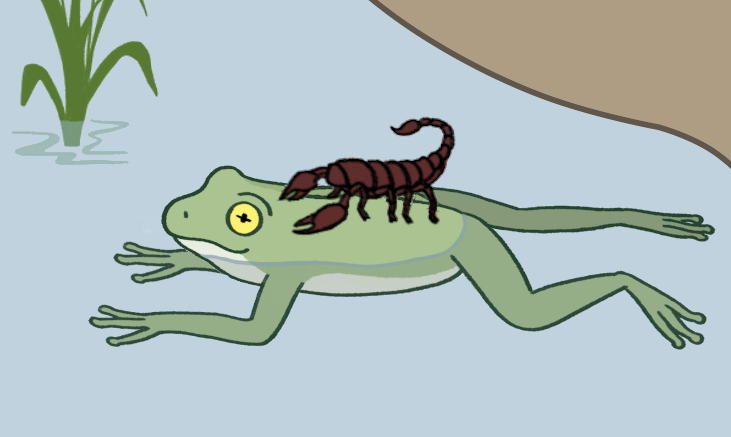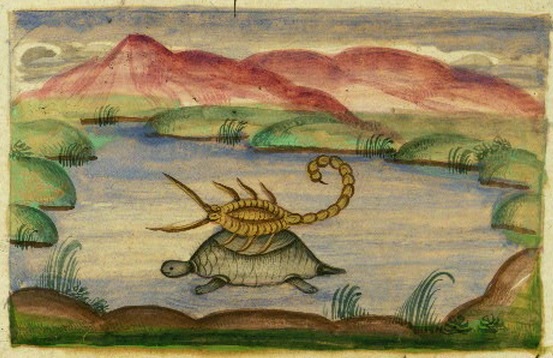The Scorpion And The Frog on:
[Wikipedia]
[Google]
[Amazon]
 ''The Scorpion and the Frog'' is an
''The Scorpion and the Frog'' is an
 A likely precursor to this fable is the
A likely precursor to this fable is the
The tortoise reflected thus, ‘Truly have the sages said that to cherish a base character is to give one's own honor to the wind, and to involve one’s own self in embarrassment.’" The moral of this fable is thus stated explicitly, and not left to interpretation. Another important difference is that the scorpion does not anticipate drowning. In some later versions of this fable, the turtle punishes the scorpion by drowning it anyway.
An English translation of this interview is available on Wellesnet.com
(May 22, 2006) * * * ** * * * * * * * * * * * * {{DEFAULTSORT:Scorpion And The Frog European folklore Fables Fictional arachnids Fictional duos Fictional frogs Scorpions in popular culture
 ''The Scorpion and the Frog'' is an
''The Scorpion and the Frog'' is an animal fable
An animal tale or beast fable generally consists of a short story or poem in which animals talk. They may exhibit other anthropomorphic qualities as well, such as living in a human-like society. It is a traditional form of allegorical writing.
A ...
which teaches that vicious people cannot resist hurting others even when it is not in their own interests. This fable seems to have emerged in Russia in the early 20th century.
Synopsis
A scorpion wants to cross a river but cannot swim, so it asks a frog to carry it across. The frog hesitates, afraid that the scorpion might sting it, but the scorpion promises not to, pointing out that it would drown if it killed the frog in the middle of the river. The frog considers this argument sensible and agrees to transport the scorpion. Midway across the river, the scorpion stings the frog anyway, dooming them both. The dying frog asks the scorpion why it stung despite knowing the consequence, to which the scorpion replies: "I am sorry, but I couldn't resist the urge. It's in my nature."Origins
The earliest known appearance of this fable is in the 1933 Russian novel, ''The German Quarter'' by Lev Nitoburg. The fable also appears in the 1944 novel, ''The Hunter of the Pamirs'', and this is the earliest known appearance of the fable in English. Tushkan (1944). ''The Hunter of the Pamirs'', p. 320. ''The Hunter of the Pamirs'' is an English translation of the 1940 Russian novel, ''Jura'' by Georgii Tushkan, but the fable does not appear in the original Russian. The fable appears in the final chapter of ''The Hunter of the Pamirs'', but does not appear at the corresponding location in ''Jura''. In the English-speaking world, the fable was made famous by the 1955 film ''Mr. Arkadin
''Mr. Arkadin'' (first released in Spain, 1955), known in Britain as ''Confidential Report'', is a French-Spanish-Swiss coproduction film, written and directed by Orson Welles and shot in several Spanish locations, including Costa Brava, Segov ...
''. It is recounted in a soliloquy by the movie's villain, played by Orson Welles
George Orson Welles (May 6, 1915 – October 10, 1985) was an American actor, director, producer, and screenwriter, known for his innovative work in film, radio and theatre. He is considered to be among the greatest and most influential f ...
.. Retrieved August 2, 2016. In an interview, Welles mentioned that the fable is Russian in origin.
Precursors
''The Scorpion and the Turtle''
 A likely precursor to this fable is the
A likely precursor to this fable is the Persian
Persian may refer to:
* People and things from Iran, historically called ''Persia'' in the English language
** Persians, the majority ethnic group in Iran, not to be conflated with the Iranic peoples
** Persian language, an Iranian language of the ...
fable of ''The Scorpion and the Turtle''. This earlier fable appears in the ''Anvaar Soheili'', a collection of fables written c. 1500 by the Persian scholar Husayn Kashifi. The ''Anvaar Soheili'' contains fables translated from the ''Panchatantra
The ''Panchatantra'' (IAST: Pañcatantra, ISO: Pañcatantra, sa, पञ्चतन्त्र, "Five Treatises") is an ancient Indian collection of interrelated animal fables in Sanskrit verse and prose, arranged within a frame story.
'', a collection of Indian fables written in Sanskrit
Sanskrit (; attributively , ; nominally , , ) is a classical language belonging to the Indo-Aryan branch of the Indo-European languages. It arose in South Asia after its predecessor languages had diffused there from the northwest in the late ...
, but ''The Scorpion and the Turtle'' does not appear in the ''Panchatantra'', which suggests that the fable is Persian in origin.
In the ''Scorpion and the Turtle'', it is a turtle that carries the scorpion across the river, and the turtle survives the scorpion's sting thanks to its protective shell. The turtle is baffled by the scorpion's behavior because they are old friends and the scorpion must have known that its stinger would not pierce the turtle's shell. The scorpion responds that it acted neither out of malice nor ingratitude, but merely an irresistible and indiscriminate urge to sting. The turtle then delivers the following reflection: "Truly have the sages said that to cherish a base character is to give one's honor to the wind, and to involve one's own self in embarrassment.": "The Scorpion answered, ‘God forbid that sentiments like these should approach my mind in the whole course of my life or should have ever done so! It is nothing more than this, that my nature instigates me to sting, whether I wound the back of a friend or the breast of a foe.
The tortoise reflected thus, ‘Truly have the sages said that to cherish a base character is to give one's own honor to the wind, and to involve one’s own self in embarrassment.’" The moral of this fable is thus stated explicitly, and not left to interpretation. Another important difference is that the scorpion does not anticipate drowning. In some later versions of this fable, the turtle punishes the scorpion by drowning it anyway.
Aesop
''The Scorpion and the Frog'' is sometimes attributed toAesop
Aesop ( or ; , ; c. 620–564 BCE) was a Greek fabulist and storyteller credited with a number of fables now collectively known as ''Aesop's Fables''. Although his existence remains unclear and no writings by him survive, numerous tales cre ...
as its true author is unknown, though it does not appear in any collection of Aesop's fables prior to the 20th century. However, there are a number of ancient fables traditionally attributed to Aesop which teach a similar moral, the closest parallels being '' The Farmer and the Viper'' and ''The Frog and the Mouse
''The'' () is a grammatical article in English, denoting persons or things already mentioned, under discussion, implied or otherwise presumed familiar to listeners, readers, or speakers. It is the definite article in English. ''The'' is the m ...
''.
Interpretations
A common interpretation of this fable is that people with vicious personalities cannot resist hurting others even when it is not in their interests. The Italian writer Giancarlo Livraghi has commented that while there are plenty of animal fables which warn against trusting vicious people, in none of these other fables is the villain irrationally self-destructive and fully aware of it. To a social psychologist, the fable may present a dispositionist view ofhuman nature
Human nature is a concept that denotes the fundamental dispositions and characteristics—including ways of thinking, feeling, and acting—that humans are said to have naturally. The term is often used to denote the essence of humankind, or ...
because it seems to reject the idea that people behave rationally according to circumstances. The French sociologist Jean-Claude Passeron
Jean-Claude Passeron (born 26 November 1930) is a French sociologist and leader of social science studies. As part of a mixed interdisciplinary team involving sociologists, historians, and anthropologists, he led the magazine ''Enquêtes''.
Bio ...
saw the scorpion as a metaphor for Machiavellian politicians who delude themselves by their unconscious tendency to rationalize their ill-conceived plans, and thereby lead themselves and their followers to ruin. The psychologist Kevin Dutton
Kevin Dutton (born 1967) is a British psychologist and writer, specialising in the study of psychopathy.
Work
He is a postdoctoral researcher at the Department of Experimental Psychology, University of Oxford, and a member of the Oxford Centre f ...
saw the scorpion as a metaphor for psychopaths
Psychopathy, sometimes considered synonymous with sociopathy, is characterized by persistent antisocial behavior, impaired empathy and remorse, and bold, disinhibited, and egotistical traits. Different conceptions of psychopathy have been u ...
, whose impulsive and vicious personalities frequently get them into unnecessary trouble, often hurting the people they depend on, such as their own families.
When the villain of the movie ''Mr. Arkadin
''Mr. Arkadin'' (first released in Spain, 1955), known in Britain as ''Confidential Report'', is a French-Spanish-Swiss coproduction film, written and directed by Orson Welles and shot in several Spanish locations, including Costa Brava, Segov ...
'' recounts this fable, he uses the word "character" in lieu of "nature", and he concludes by saying "let's drink to character". For director Orson Welles
George Orson Welles (May 6, 1915 – October 10, 1985) was an American actor, director, producer, and screenwriter, known for his innovative work in film, radio and theatre. He is considered to be among the greatest and most influential f ...
, the word "character" had two meanings: it could mean one's natural instincts, but also how one chooses to behave. The scorpion couldn't resist its natural urge to sting, but it also chose to be honest about it to the frog. Orson Welles believed that this frankness gave the scorpion a certain charm and tragic dignity.
Other contexts
Since the fable's narration in ''Mr. Arkadin'', it has been recounted in other films, such as '' Skin Deep'' (1989), ''The Crying Game
''The Crying Game'' is a 1992 thriller film written and directed by Neil Jordan, produced by Stephen Woolley, and starring Stephen Rea, Miranda Richardson, Jaye Davidson, Adrian Dunbar, Ralph Brown, and Forest Whitaker. The film explores the ...
'' (1992), ''Drive
Drive or The Drive may refer to:
Motoring
* Driving, the act of controlling a vehicle
* Road trip, a journey on roads
Roadways
Roadways called "drives" may include:
* Driveway, a private road for local access to structures, abbreviated "drive"
...
'' (2011), and ''The Devil's Carnival
''The Devil's Carnival'' is a 2012 American musical horror film directed by Darren Lynn Bousman and starring Sean Patrick Flanery, Briana Evigan, Jessica Lowndes, Paul Sorvino, Emilie Autumn and Terrance Zdunich. The film marks the second collab ...
'' (2012). In addition, references to the fable have appeared in comics, television shows, and in newspaper articles, some of which have applied it to the relationship between big business and government and to politics, especially the bitter nature of Middle Eastern politics such as the Arab–Israeli conflict
The Arab–Israeli conflict is an ongoing intercommunal phenomenon involving political tension, military conflicts, and other disputes between Arab countries and Israel, which escalated during the 20th century, but had mostly faded out by the ...
and in Iran.
Footnotes
Bibliography
* *An English translation of this interview is available on Wellesnet.com
(May 22, 2006) * * * ** * * * * * * * * * * * * {{DEFAULTSORT:Scorpion And The Frog European folklore Fables Fictional arachnids Fictional duos Fictional frogs Scorpions in popular culture